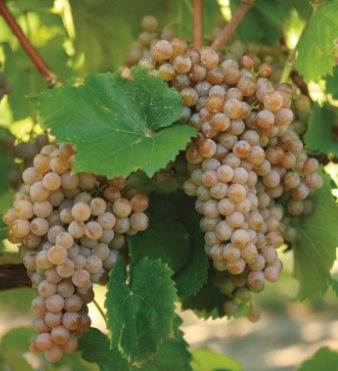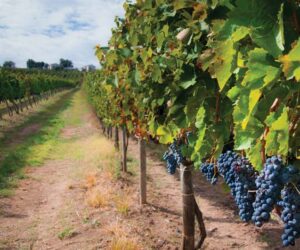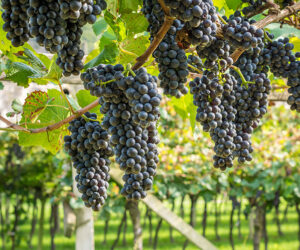 It is so wonderful to have such friends and colleagues at WineMaker magazine who keep inviting me back to speak at the annual conference (and I am looking forward to San Diego, California next May and hope to see you there as well). As I reflect back on this past year’s conference in Ithaca, New York I recall what I really like about the conferences; the enthusiasm, zest for knowledge, and then of course the diversity of wines we get to experience. Of greatest interest to me is the diversity of the varieties I rarely have the opportunity to taste in my home state of California. California’s climate is such that by and large, Vitis vinifera, or the European wine grape, makes up greater than 99% of wine grapes grown statewide. While hybrids or vinifera crosses have been developed for the California climate, they just have not caught on here even though some may do very well in certain climates of our state. As a winemaker, I appreciate hybrids in that they were created to fill a niche that Vitis vinifera cannot fill in certain localities.
It is so wonderful to have such friends and colleagues at WineMaker magazine who keep inviting me back to speak at the annual conference (and I am looking forward to San Diego, California next May and hope to see you there as well). As I reflect back on this past year’s conference in Ithaca, New York I recall what I really like about the conferences; the enthusiasm, zest for knowledge, and then of course the diversity of wines we get to experience. Of greatest interest to me is the diversity of the varieties I rarely have the opportunity to taste in my home state of California. California’s climate is such that by and large, Vitis vinifera, or the European wine grape, makes up greater than 99% of wine grapes grown statewide. While hybrids or vinifera crosses have been developed for the California climate, they just have not caught on here even though some may do very well in certain climates of our state. As a winemaker, I appreciate hybrids in that they were created to fill a niche that Vitis vinifera cannot fill in certain localities.
One of my favorite varieties is Gewürztraminer, a white grape with origins in the Alsace-Lorraine departments of France recognized for its prominent terpenic aromatic characters. On the trip to New York, I had the pleasure to taste and learn about Traminette. A little catchy name for a grape that is not the “little Gewürztraminer,” but a hybrid wine grape showcasing the aromatics of Gewürztraminer but viticulturally adaptable in regions from Illinois to New York. No state is ever more proud of its Traminette than the Hoosier state of Indiana, where it has been declared the signature wine variety.
A white grape, Traminette is a hybrid produced from one of the Joannes Seyve hybrids (specifically 24.416) and Gewürztraminer. The aromatic terpenes are evident in Traminette, yet are toned down. What also makes Traminette desirable is that it is late to bud but ripens mid-season, allowing it to develop mature varietal character in advance of the cool fall temperatures. It buds out about two weeks later than other varieties in the springtime to reduce the risk of frost damage. It is described as having superior wine quality with good productivity. And very important in the regions for which it is grown, it is cold hardy.
H.C. Barrett first made the cross in 1965 at the University of Illinois with the original intention of making a table grape with the flavor of Gewürztraminer. Seeds from the cross were sent to Cornell’s grape breeding program and first planted to field trials in 1968. Fruit was first produced from the vines in 1971 and the original vine was propagated using cuttings in 1974. It underwent years of field trials. Cornell did not officially release it until 1996, and interestingly Cornell applied for no patent.
This successful cross appears to have blossomed into a variety that was desirable on many fronts from a viticultural standpoint. Traminette is able to tolerate phylloxera (Daktulosphaira vitifoliae) when grown on its own roots. It shows moderate resistance to powdery mildew (Uncinula necator), black rot (Guignardia bidwellii) and Botrytis bunch rot (Botrytis cinerea). On the downside, it is susceptible to downey mildew (Plasmopara viticola), but as with the case of most vineyards, a good fungicide spray program should be employed to fight this. Your local university extension outreach programs can help determine how best to protect the vines.
But the real experience with any variety is once it gets put into commercial production. This is a time when it gets distributed to multiple growers on a variety of sites, each with unique growing conditions. These growers work closely with their local university extension folks to compile what is learned from their experiences. Some of the most extensive published work is that from Purdue University in Indiana, where its “signature” classification has led to research funding on what makes it tick, and how to make it tick better.
Purdue’s publications report that Traminette is well suited for cold winters, with limitations of course. In Indiana, it survives primary bud kill in most winters of average minimum temperatures. Cornell’s research reported the minimum average temperature it can survive is -13.8 °F (-25.4 °C). In 2009, when temperatures dropped to -18 °F (-28 °C) in Indiana, Traminette only suffered a 50% primary bud kill, compared to 90% for other hybrids. With proper pruning and training, even after the coldest of winters, growers can still produce a full crop.
With Traminette, vineyard canopy management is the key. Understanding canopy management means that you have to understand your site. As previously stated, Traminette can be grown on its own roots because of its apparent tolerance to phylloxera, but if a site is too fertile, or vigorous as the viticulture folks often say, the vine will produce too much canopy and the fruit will be shaded too much. While direct exposure to sunlight is not good and can lead to sunburn, indirect sunlight is needed to help develop the aromatic compounds that are signature to the variety. Shading trials have shown that heavily shaded fruit can have less than half the concentration of terpenes than that of exposed fruit. Removing the leaves on the east side of the canopy, which exposes the fruit to the morning sun, will accomplish this and improve airflow through the fruiting zone, which can help reduce fungal disease pressure. Training systems also go a long way in canopy management and exposing the fruit to sunlight in a controlled way. Using a vertical shoot position, or VSP trellis system, in conjunction with cane pruning will easily facilitate leaf removal. The disadvantage here is that this upright training can lead to vegetative vigor, so the VSP is best used in low to moderate vigor growing sites. Becoming more popular, perhaps only for me, is the use of a high wire system that directs the growth in a downward direction. Training downward has been found to naturally reduce vine vigor and several commercial systems are available. On extremely fertile sites, dividing the canopy using the Geneva Double Curtain, or GDC, or the Scott-Henry trellis may be required.
Fruit loads in any given season do not have to be adjusted. It is not a real big fruit producer like other hybrids. Estimates from growers and field trials show individual vine yields of 12–20 pounds (5.4–9 kg), and pruning weights 2–3.5 pounds (0.9–1.6 kg) per vine. However, removing fruit in the first through third seasons will help the vine direct more energy to vegetative growth for the long-term health and balance of the vine.
Because flavors develop over the entire growing season, maximizing that time on the vine goes a long way to obtain mature ripe flavors in the fruit. This is often a difficult prospect in areas of the country that can see an early winter. There also exists the risk of unwanted pests or diseases to spoil the fruit. Work with the grower to maximize the hang time to achieve the optimal harvest parameters.
At harvest, the sugar should be about 20–24 °Brix, titratable acidity around 8 g/L, and pH approximately 3.3. An indication of mature fruit, in addition to the aforementioned chemical parameters, is light golden fruit.
Harvest should be done when conditions are cool. Chill the fruit to 60–70 °F (16–21 °C) if possible prior to processing. De-stem and then crush the fruit, adding 75 mg/L of sulfur dioxide to the must to prevent browning. Press the fruit as soon as possible, extended skin contact is not recommended as this can lead to off-flavors. Avoid over-pressing. If you can measure the press pressures do not exceed 1.2 bar (18 psi). Cold settle the juice at least overnight and rack off the gross solids. Once the juice is clarified, initiate fermentation and a cool temperature. The ability to hold the temperature at 55–58 °F (13–14 °C) ensures that the evolving carbon dioxide will not strip the wine of its precious volatile flavors.
The ultimate goal with Traminette is to showcase the variety’s aromatics, so therefore your stylistic options are limited. Barrel aging or enhancing buttery characters via malolactic fermentation are out for this variety. Creating a final wine with crisp acidity and a coating mouthfeel can be achieved by balancing the acidity with some residual sugar (RS), with or without sur lie aging. Some experts recommend 15 g/L RS with about 7.5 g/L titratable acidity. Residual sugar levels of 30 g/L or greater can be applied to wines destined for table wines or dessert styles depending on taste. Leaving residual sugar in the wine presents some risk for refermentation in the bottle, so sterile filtration and/or the use of potassium sorbate need to be considered.
Traveling to other wine regions is an experience of discovery for me. I never know what I am going to find, and what I do find is a great learning experience for me. For those in Traminette country, you are so lucky because this variety is a gemstone and justifies being discovered beyond its home range. I am grateful to the winery owner who took the time to taste through his Traminettes. I am always one to try something new, and in this case am definitely happy I did!
Traminette Recipe (5 gallons/ 19 L)
Ingredients
100 lbs. (45 kg) Traminette fruit
Distilled water
10% potassium metabisulfite (KMBS) solution. Weigh 10 grams of KMBS, dissolve into about 75 milliliters (mL) of distilled water. When completely dissolved, make up to 100 mL total with distilled water.
5 grams Lallemand QA23 or Premier Cuvée yeast
5 grams Fermaid K (or equivalent yeast nutrient)
5 grams di-ammonium phosphate (DAP)
Potassium Sorbate
Other equipment or needs
Destemmer-crusher
Basket press
Food-grade plastic tub (about 18 gallons/68 L)
5-gallon (19-L) carboy
6-gallon (23-L) carboy
6-gallon (23-L) plastic bucket
Airlock/stopper
Racking hoses
Equipment cleaning and sanitizing agents (Bio-Clean, Bio-San)
Inert gas (nitrogen, argon, or carbon dioxide)
Refrigerator (~45 °F/7 °C)
Ability to maintain a fermentation temperature of 55 °F (13 °C).
Thermometer capable of measuring between 40–110 °F (4–43 °C) in one degree increments
Pipettes with the ability to add in increments of 1 mL
Step by Step
1. Crush and press the grapes. Do not delay between crushing and pressing. Move the must directly to the press and press lightly to avoid extended contact with the skins and seeds.
2. Transfer the juice to a 6-gallon (23-L) bucket. During the transfer, add 29 mL of 10% KMBS solution (This addition is the equivalent of 75 mg/L (ppm) SO2). Move the juice to the refrigerator.
3. Let the juice settle at least overnight. Layer the headspace with inert gas and keep covered.
4. When sufficiently settled, rack the juice off of the solids into the 6-gallon (23-L) carboy.
5. Prepare yeast. Heat about 50 mL distilled water to 104 °F (42 °C). Sprinkle the yeast on the surface of the water and gently mix so that no clumps exist. Let sit for 15 minutes undisturbed. Measure the temperature of the yeast suspension and the juice. You do not want to add the yeast to your cool juice if the difference in temperatures of the yeast and must exceeds 15 °F (8 °C). To avoid temperature shock, acclimate your yeast by taking about 10 mL of the juice and adding it to the yeast suspension. Wait 15 minutes and measure the temperature again. Do this until you are within the specified temperature range. Do not let the yeast sit in the original water suspension for longer than 20 minutes. When the yeast is ready, add it to the fermenter.
6. Add Fermaid K or equivalent yeast nutrient and stir thoroughly.
7. Initiate the fermentation at room temperature, about 65–68 °F (18–20 °C). Once fermentation is noticed, (~24 hours) move to a location where the temperature can be maintained at 55 °F (13 °C).
8. Two days after fermentation starts, dissolve the DAP in as little distilled water as required to completely go into solution (~20 mL). Add to the carboy and stir.
9. Normally you would monitor the progress of the fermentation by measuring Brix. One of the biggest problems with making white wine at home is maintaining a clean fermentation. Entering the carboy to measure the sugar is a prime way to infect the fermentation with undesirable microbes. So at this point, the presence of noticeable fermentation is good enough. If your airlock becomes dirty by foaming over, remove, clean, and replace it as quickly and cleanly as possible. Sanitize anything that will come in contact with the fermenting juice.
10. Leave alone until bubbles in the airlock are about one bubble per minute. Usually about two to three weeks. At this point, begin to measure the Brix every couple days.
11. Taste the wine with each Brix measurement. This is strictly a personal preference as to how sweet you want it. Once you achieve the desired taste, add 29 mL 10% KMBS and chill as cold as you can get it in the refrigerator. Ideally 38–40 °F (3–4 °C).
12. The wine should begin to clarify and after 2–3 days transfer the wine to the 5-gallon (19-L) carboy to reduce your headspace. Keep it cold.
13. After two weeks, test for pH and SO2 and then adjust as necessary to attain 0.8 ppm molecular SO2. (Use the SO2 calculator at www.winemakermag.com/guide/sulfite). With these addition rates, you should not have to add sulfur dioxide, but it is best to check to make sure. Check the SO2 in another two weeks, prior to the next racking and adjust while racking. HINT: Rack to another sanitized 5-gallon (19 L) carboy, or your bucket. In the case of the latter, clean and sanitize the original carboy and transfer the wine back to it. This is done 4-6 weeks after the first SO2 addition. Once the free SO2 is adjusted, maintain at the target level by monitoring every 3-4 weeks.
14. Fine or filter the wine if you choose to. You may consider stirring the lees once or twice but the undisturbed settling time should be at least one month.
15. Keep it cold and at about three months you are ready to bottle. With residual sugar comes a risk of refermentation in the bottle, so consider sterile filtering and/or adding potassium sorbate just prior to bottling. Be sure to maintain sanitary conditions while bottling. Once bottled, you’ll need to periodically check your work by opening a bottle to enjoy with friends.






